Engineering Ethics: Moral Principles in Self-Driving Cars
VerifiedAdded on 2023/01/23
|10
|2220
|25
AI Summary
This article discusses the moral principles and ethical dilemmas in engineering practices, specifically focusing on self-driving cars. It explores topics such as crash optimization, transparency, and stakeholder considerations. The article also examines the contractarian and utilitarian approaches to decision-making in autonomous vehicles.
Contribute Materials
Your contribution can guide someone’s learning journey. Share your
documents today.
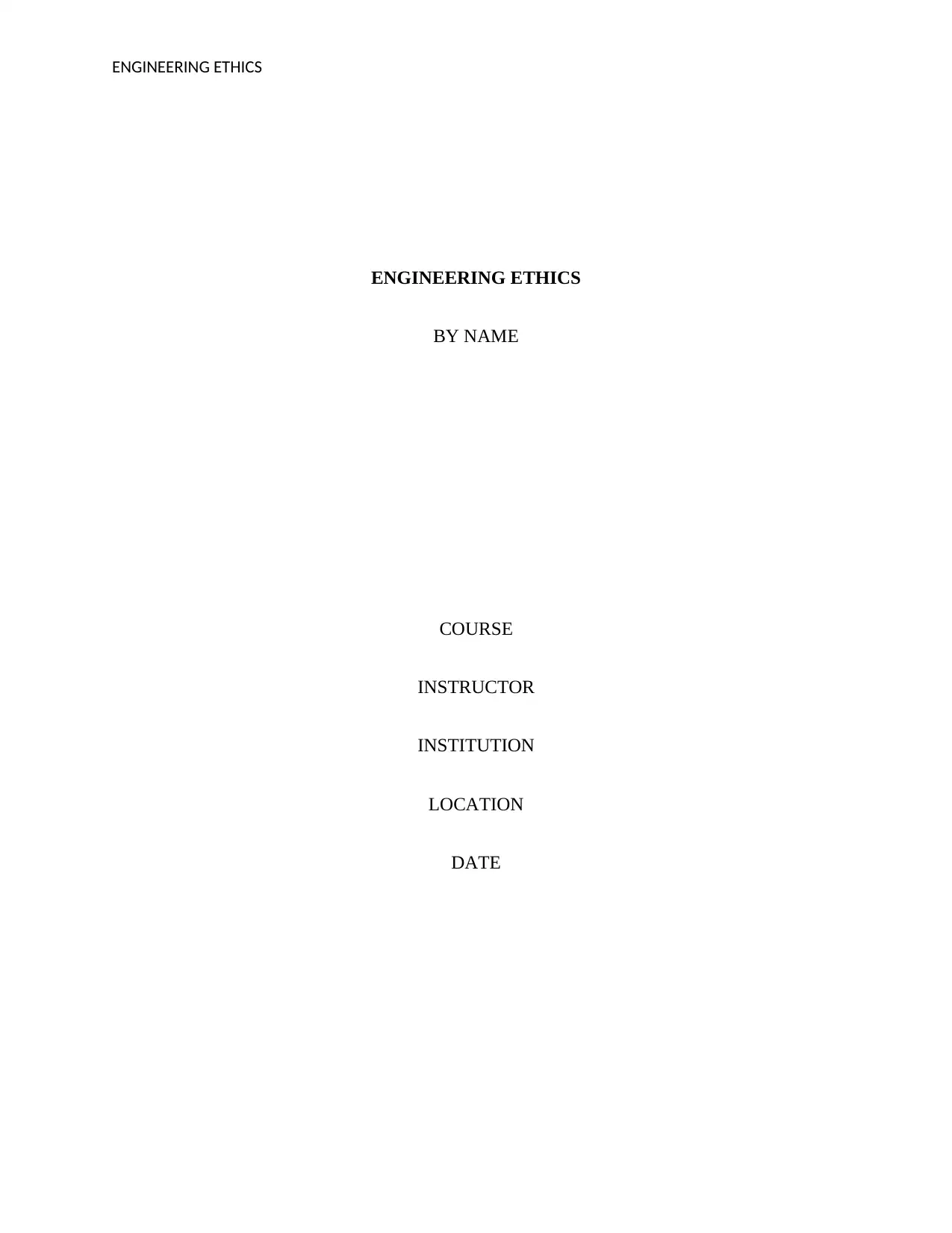
ENGINEERING ETHICS
ENGINEERING ETHICS
BY NAME
COURSE
INSTRUCTOR
INSTITUTION
LOCATION
DATE
ENGINEERING ETHICS
BY NAME
COURSE
INSTRUCTOR
INSTITUTION
LOCATION
DATE
Secure Best Marks with AI Grader
Need help grading? Try our AI Grader for instant feedback on your assignments.
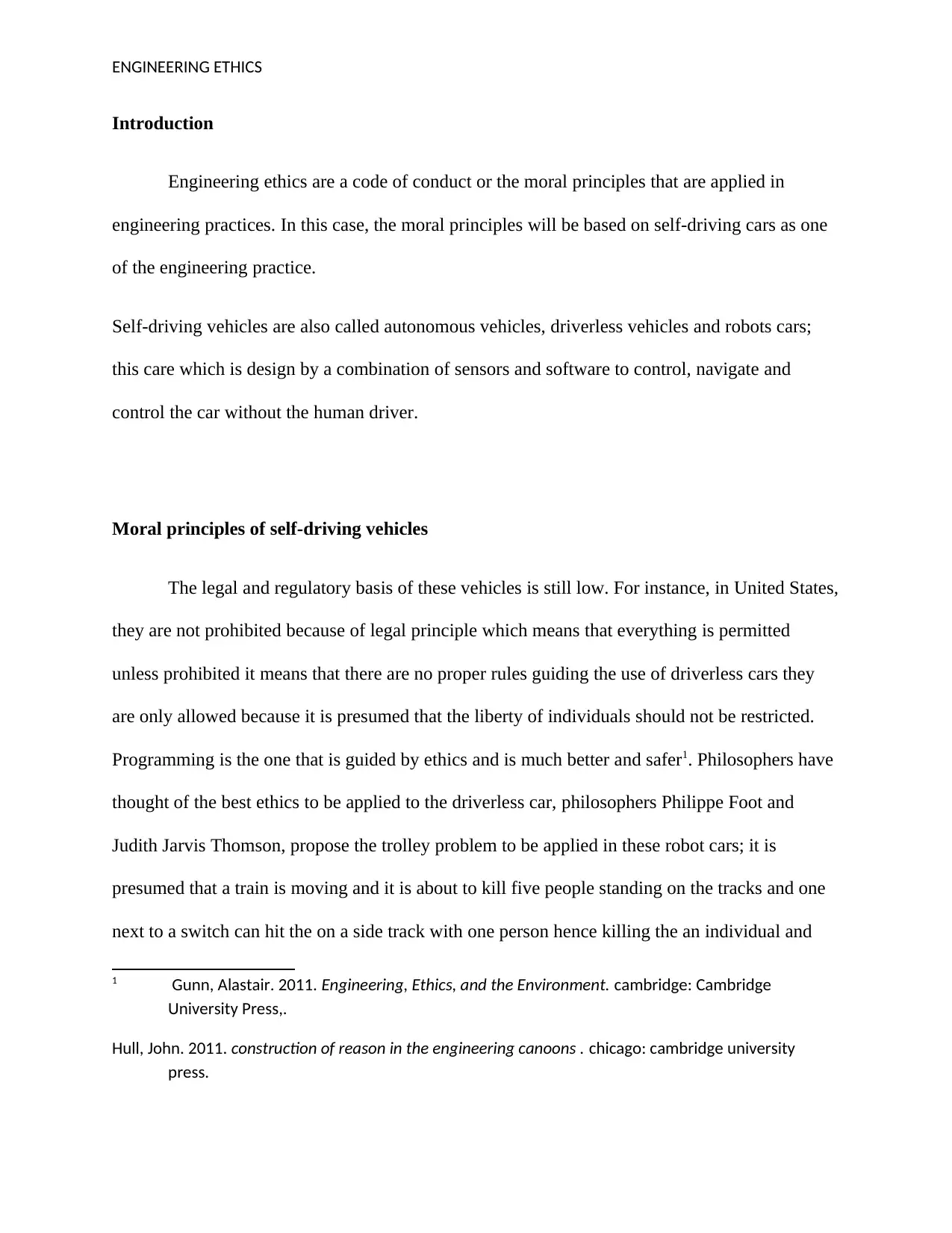
ENGINEERING ETHICS
Introduction
Engineering ethics are a code of conduct or the moral principles that are applied in
engineering practices. In this case, the moral principles will be based on self-driving cars as one
of the engineering practice.
Self-driving vehicles are also called autonomous vehicles, driverless vehicles and robots cars;
this care which is design by a combination of sensors and software to control, navigate and
control the car without the human driver.
Moral principles of self-driving vehicles
The legal and regulatory basis of these vehicles is still low. For instance, in United States,
they are not prohibited because of legal principle which means that everything is permitted
unless prohibited it means that there are no proper rules guiding the use of driverless cars they
are only allowed because it is presumed that the liberty of individuals should not be restricted.
Programming is the one that is guided by ethics and is much better and safer1. Philosophers have
thought of the best ethics to be applied to the driverless car, philosophers Philippe Foot and
Judith Jarvis Thomson, propose the trolley problem to be applied in these robot cars; it is
presumed that a train is moving and it is about to kill five people standing on the tracks and one
next to a switch can hit the on a side track with one person hence killing the an individual and
1 Gunn, Alastair. 2011. Engineering, Ethics, and the Environment. cambridge: Cambridge
University Press,.
Hull, John. 2011. construction of reason in the engineering canoons . chicago: cambridge university
press.
Introduction
Engineering ethics are a code of conduct or the moral principles that are applied in
engineering practices. In this case, the moral principles will be based on self-driving cars as one
of the engineering practice.
Self-driving vehicles are also called autonomous vehicles, driverless vehicles and robots cars;
this care which is design by a combination of sensors and software to control, navigate and
control the car without the human driver.
Moral principles of self-driving vehicles
The legal and regulatory basis of these vehicles is still low. For instance, in United States,
they are not prohibited because of legal principle which means that everything is permitted
unless prohibited it means that there are no proper rules guiding the use of driverless cars they
are only allowed because it is presumed that the liberty of individuals should not be restricted.
Programming is the one that is guided by ethics and is much better and safer1. Philosophers have
thought of the best ethics to be applied to the driverless car, philosophers Philippe Foot and
Judith Jarvis Thomson, propose the trolley problem to be applied in these robot cars; it is
presumed that a train is moving and it is about to kill five people standing on the tracks and one
next to a switch can hit the on a side track with one person hence killing the an individual and
1 Gunn, Alastair. 2011. Engineering, Ethics, and the Environment. cambridge: Cambridge
University Press,.
Hull, John. 2011. construction of reason in the engineering canoons . chicago: cambridge university
press.
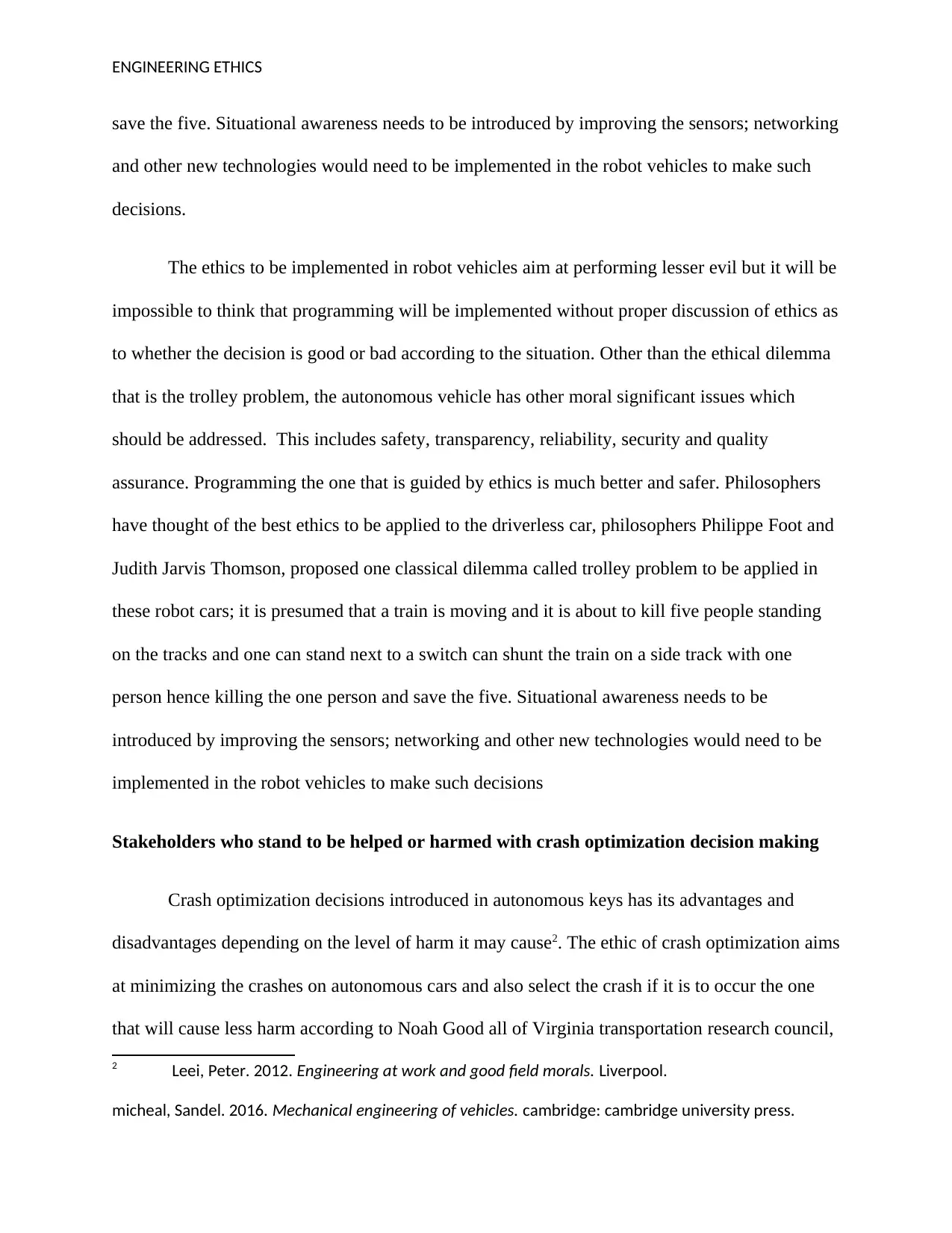
ENGINEERING ETHICS
save the five. Situational awareness needs to be introduced by improving the sensors; networking
and other new technologies would need to be implemented in the robot vehicles to make such
decisions.
The ethics to be implemented in robot vehicles aim at performing lesser evil but it will be
impossible to think that programming will be implemented without proper discussion of ethics as
to whether the decision is good or bad according to the situation. Other than the ethical dilemma
that is the trolley problem, the autonomous vehicle has other moral significant issues which
should be addressed. This includes safety, transparency, reliability, security and quality
assurance. Programming the one that is guided by ethics is much better and safer. Philosophers
have thought of the best ethics to be applied to the driverless car, philosophers Philippe Foot and
Judith Jarvis Thomson, proposed one classical dilemma called trolley problem to be applied in
these robot cars; it is presumed that a train is moving and it is about to kill five people standing
on the tracks and one can stand next to a switch can shunt the train on a side track with one
person hence killing the one person and save the five. Situational awareness needs to be
introduced by improving the sensors; networking and other new technologies would need to be
implemented in the robot vehicles to make such decisions
Stakeholders who stand to be helped or harmed with crash optimization decision making
Crash optimization decisions introduced in autonomous keys has its advantages and
disadvantages depending on the level of harm it may cause2. The ethic of crash optimization aims
at minimizing the crashes on autonomous cars and also select the crash if it is to occur the one
that will cause less harm according to Noah Good all of Virginia transportation research council,
2 Leei, Peter. 2012. Engineering at work and good field morals. Liverpool.
micheal, Sandel. 2016. Mechanical engineering of vehicles. cambridge: cambridge university press.
save the five. Situational awareness needs to be introduced by improving the sensors; networking
and other new technologies would need to be implemented in the robot vehicles to make such
decisions.
The ethics to be implemented in robot vehicles aim at performing lesser evil but it will be
impossible to think that programming will be implemented without proper discussion of ethics as
to whether the decision is good or bad according to the situation. Other than the ethical dilemma
that is the trolley problem, the autonomous vehicle has other moral significant issues which
should be addressed. This includes safety, transparency, reliability, security and quality
assurance. Programming the one that is guided by ethics is much better and safer. Philosophers
have thought of the best ethics to be applied to the driverless car, philosophers Philippe Foot and
Judith Jarvis Thomson, proposed one classical dilemma called trolley problem to be applied in
these robot cars; it is presumed that a train is moving and it is about to kill five people standing
on the tracks and one can stand next to a switch can shunt the train on a side track with one
person hence killing the one person and save the five. Situational awareness needs to be
introduced by improving the sensors; networking and other new technologies would need to be
implemented in the robot vehicles to make such decisions
Stakeholders who stand to be helped or harmed with crash optimization decision making
Crash optimization decisions introduced in autonomous keys has its advantages and
disadvantages depending on the level of harm it may cause2. The ethic of crash optimization aims
at minimizing the crashes on autonomous cars and also select the crash if it is to occur the one
that will cause less harm according to Noah Good all of Virginia transportation research council,
2 Leei, Peter. 2012. Engineering at work and good field morals. Liverpool.
micheal, Sandel. 2016. Mechanical engineering of vehicles. cambridge: cambridge university press.
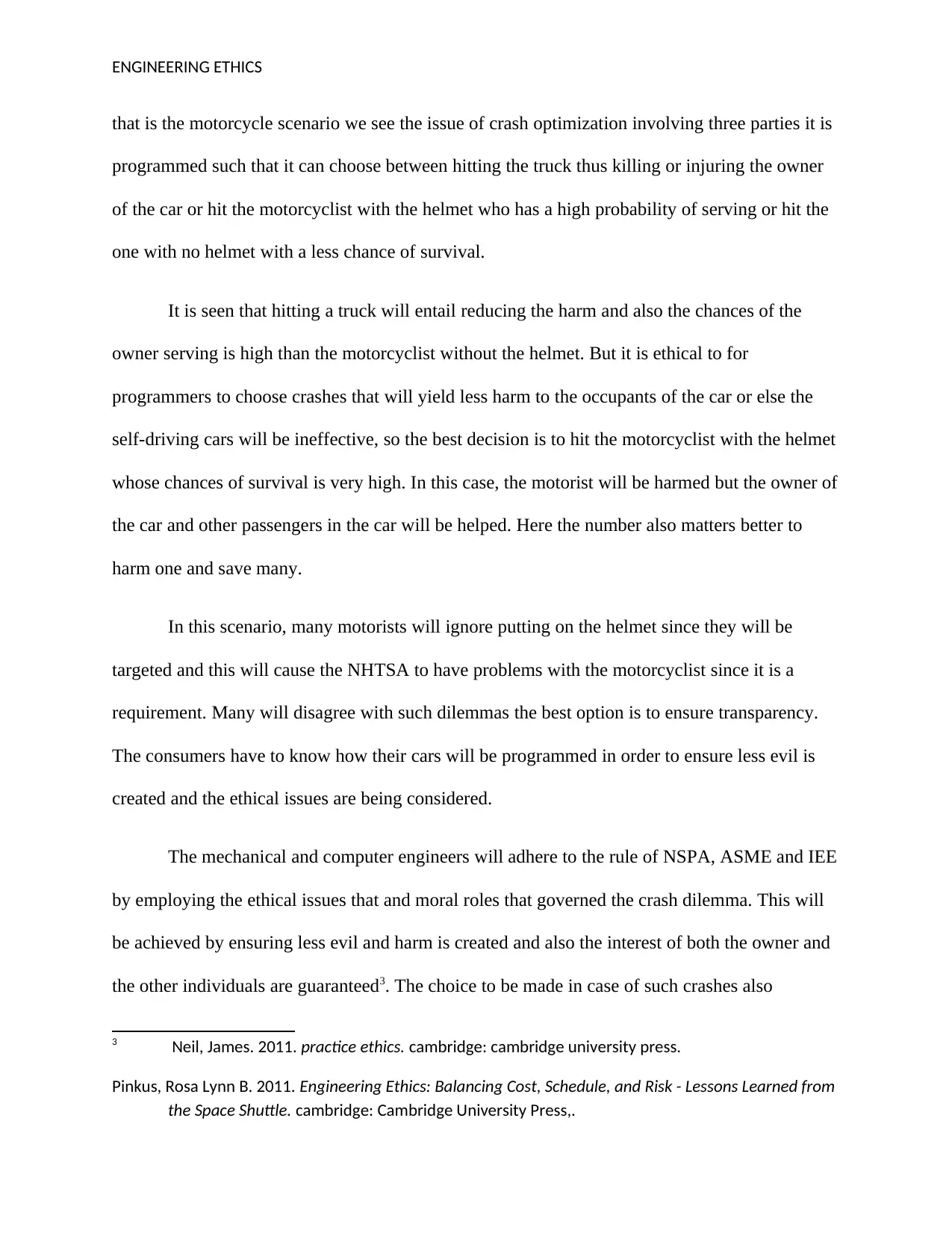
ENGINEERING ETHICS
that is the motorcycle scenario we see the issue of crash optimization involving three parties it is
programmed such that it can choose between hitting the truck thus killing or injuring the owner
of the car or hit the motorcyclist with the helmet who has a high probability of serving or hit the
one with no helmet with a less chance of survival.
It is seen that hitting a truck will entail reducing the harm and also the chances of the
owner serving is high than the motorcyclist without the helmet. But it is ethical to for
programmers to choose crashes that will yield less harm to the occupants of the car or else the
self-driving cars will be ineffective, so the best decision is to hit the motorcyclist with the helmet
whose chances of survival is very high. In this case, the motorist will be harmed but the owner of
the car and other passengers in the car will be helped. Here the number also matters better to
harm one and save many.
In this scenario, many motorists will ignore putting on the helmet since they will be
targeted and this will cause the NHTSA to have problems with the motorcyclist since it is a
requirement. Many will disagree with such dilemmas the best option is to ensure transparency.
The consumers have to know how their cars will be programmed in order to ensure less evil is
created and the ethical issues are being considered.
The mechanical and computer engineers will adhere to the rule of NSPA, ASME and IEE
by employing the ethical issues that and moral roles that governed the crash dilemma. This will
be achieved by ensuring less evil and harm is created and also the interest of both the owner and
the other individuals are guaranteed3. The choice to be made in case of such crashes also
3 Neil, James. 2011. practice ethics. cambridge: cambridge university press.
Pinkus, Rosa Lynn B. 2011. Engineering Ethics: Balancing Cost, Schedule, and Risk - Lessons Learned from
the Space Shuttle. cambridge: Cambridge University Press,.
that is the motorcycle scenario we see the issue of crash optimization involving three parties it is
programmed such that it can choose between hitting the truck thus killing or injuring the owner
of the car or hit the motorcyclist with the helmet who has a high probability of serving or hit the
one with no helmet with a less chance of survival.
It is seen that hitting a truck will entail reducing the harm and also the chances of the
owner serving is high than the motorcyclist without the helmet. But it is ethical to for
programmers to choose crashes that will yield less harm to the occupants of the car or else the
self-driving cars will be ineffective, so the best decision is to hit the motorcyclist with the helmet
whose chances of survival is very high. In this case, the motorist will be harmed but the owner of
the car and other passengers in the car will be helped. Here the number also matters better to
harm one and save many.
In this scenario, many motorists will ignore putting on the helmet since they will be
targeted and this will cause the NHTSA to have problems with the motorcyclist since it is a
requirement. Many will disagree with such dilemmas the best option is to ensure transparency.
The consumers have to know how their cars will be programmed in order to ensure less evil is
created and the ethical issues are being considered.
The mechanical and computer engineers will adhere to the rule of NSPA, ASME and IEE
by employing the ethical issues that and moral roles that governed the crash dilemma. This will
be achieved by ensuring less evil and harm is created and also the interest of both the owner and
the other individuals are guaranteed3. The choice to be made in case of such crashes also
3 Neil, James. 2011. practice ethics. cambridge: cambridge university press.
Pinkus, Rosa Lynn B. 2011. Engineering Ethics: Balancing Cost, Schedule, and Risk - Lessons Learned from
the Space Shuttle. cambridge: Cambridge University Press,.
Secure Best Marks with AI Grader
Need help grading? Try our AI Grader for instant feedback on your assignments.
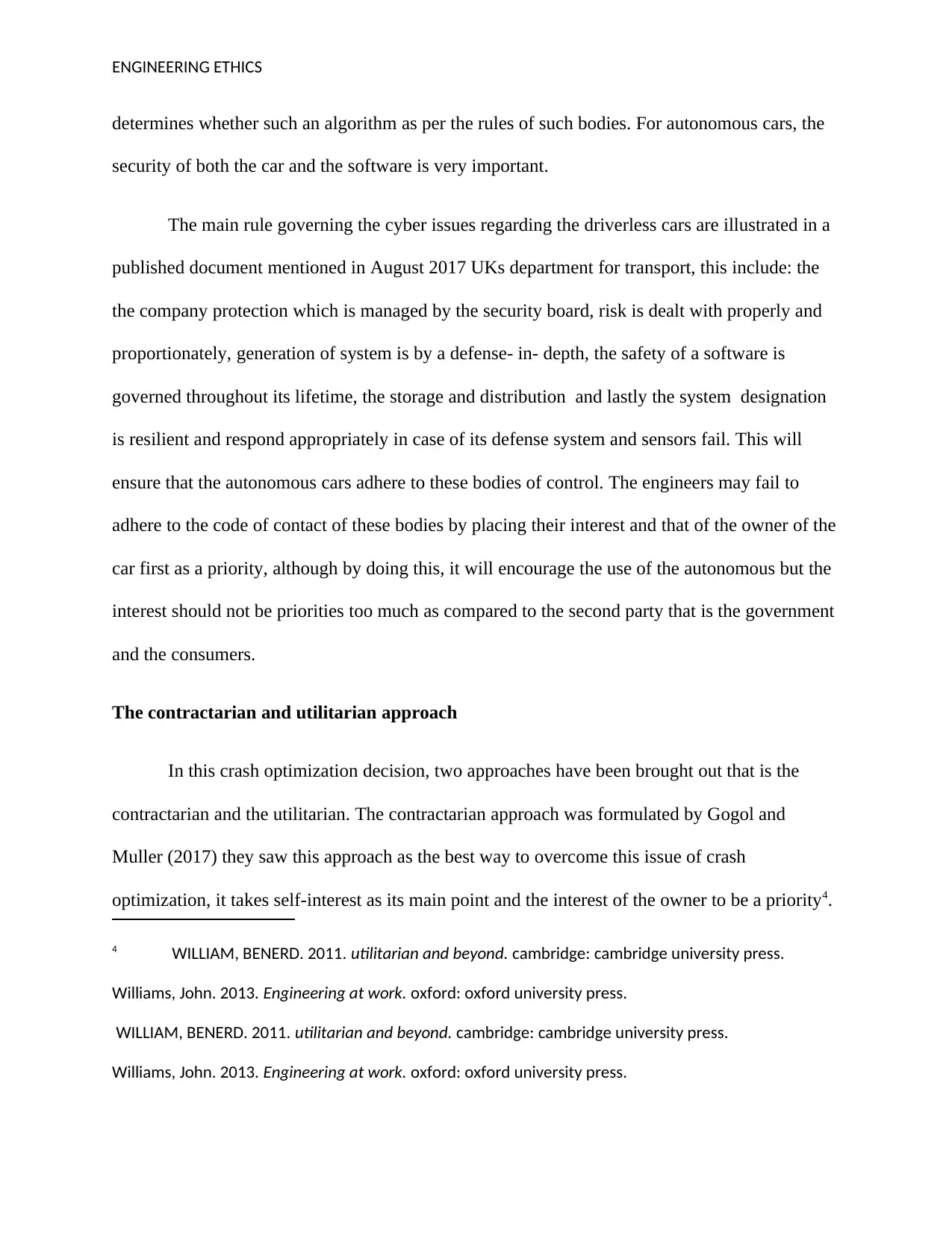
ENGINEERING ETHICS
determines whether such an algorithm as per the rules of such bodies. For autonomous cars, the
security of both the car and the software is very important.
The main rule governing the cyber issues regarding the driverless cars are illustrated in a
published document mentioned in August 2017 UKs department for transport, this include: the
the company protection which is managed by the security board, risk is dealt with properly and
proportionately, generation of system is by a defense- in- depth, the safety of a software is
governed throughout its lifetime, the storage and distribution and lastly the system designation
is resilient and respond appropriately in case of its defense system and sensors fail. This will
ensure that the autonomous cars adhere to these bodies of control. The engineers may fail to
adhere to the code of contact of these bodies by placing their interest and that of the owner of the
car first as a priority, although by doing this, it will encourage the use of the autonomous but the
interest should not be priorities too much as compared to the second party that is the government
and the consumers.
The contractarian and utilitarian approach
In this crash optimization decision, two approaches have been brought out that is the
contractarian and the utilitarian. The contractarian approach was formulated by Gogol and
Muller (2017) they saw this approach as the best way to overcome this issue of crash
optimization, it takes self-interest as its main point and the interest of the owner to be a priority4.
4 WILLIAM, BENERD. 2011. utilitarian and beyond. cambridge: cambridge university press.
Williams, John. 2013. Engineering at work. oxford: oxford university press.
WILLIAM, BENERD. 2011. utilitarian and beyond. cambridge: cambridge university press.
Williams, John. 2013. Engineering at work. oxford: oxford university press.
determines whether such an algorithm as per the rules of such bodies. For autonomous cars, the
security of both the car and the software is very important.
The main rule governing the cyber issues regarding the driverless cars are illustrated in a
published document mentioned in August 2017 UKs department for transport, this include: the
the company protection which is managed by the security board, risk is dealt with properly and
proportionately, generation of system is by a defense- in- depth, the safety of a software is
governed throughout its lifetime, the storage and distribution and lastly the system designation
is resilient and respond appropriately in case of its defense system and sensors fail. This will
ensure that the autonomous cars adhere to these bodies of control. The engineers may fail to
adhere to the code of contact of these bodies by placing their interest and that of the owner of the
car first as a priority, although by doing this, it will encourage the use of the autonomous but the
interest should not be priorities too much as compared to the second party that is the government
and the consumers.
The contractarian and utilitarian approach
In this crash optimization decision, two approaches have been brought out that is the
contractarian and the utilitarian. The contractarian approach was formulated by Gogol and
Muller (2017) they saw this approach as the best way to overcome this issue of crash
optimization, it takes self-interest as its main point and the interest of the owner to be a priority4.
4 WILLIAM, BENERD. 2011. utilitarian and beyond. cambridge: cambridge university press.
Williams, John. 2013. Engineering at work. oxford: oxford university press.
WILLIAM, BENERD. 2011. utilitarian and beyond. cambridge: cambridge university press.
Williams, John. 2013. Engineering at work. oxford: oxford university press.
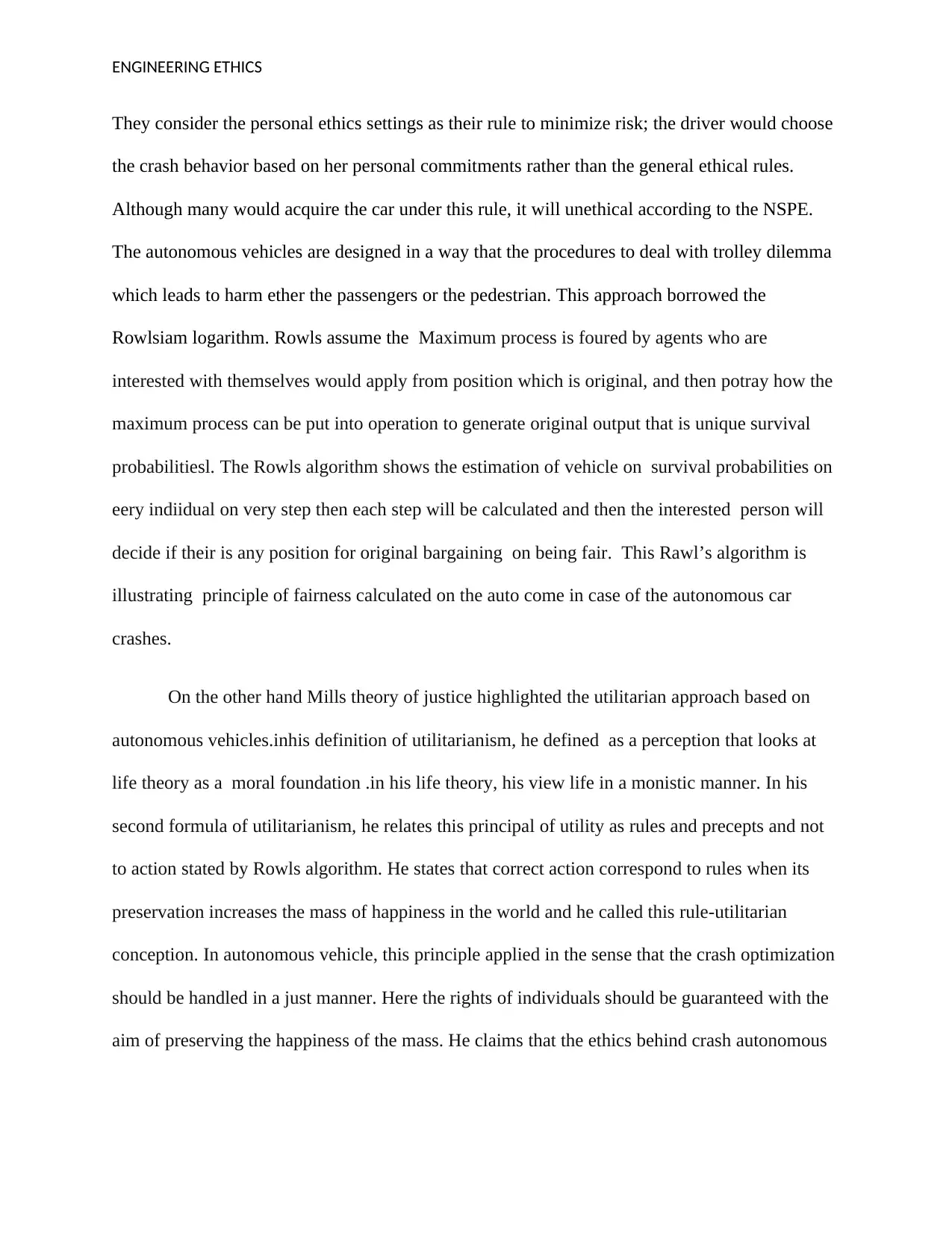
ENGINEERING ETHICS
They consider the personal ethics settings as their rule to minimize risk; the driver would choose
the crash behavior based on her personal commitments rather than the general ethical rules.
Although many would acquire the car under this rule, it will unethical according to the NSPE.
The autonomous vehicles are designed in a way that the procedures to deal with trolley dilemma
which leads to harm ether the passengers or the pedestrian. This approach borrowed the
Rowlsiam logarithm. Rowls assume the Maximum process is foured by agents who are
interested with themselves would apply from position which is original, and then potray how the
maximum process can be put into operation to generate original output that is unique survival
probabilitiesl. The Rowls algorithm shows the estimation of vehicle on survival probabilities on
eery indiidual on very step then each step will be calculated and then the interested person will
decide if their is any position for original bargaining on being fair. This Rawl’s algorithm is
illustrating principle of fairness calculated on the auto come in case of the autonomous car
crashes.
On the other hand Mills theory of justice highlighted the utilitarian approach based on
autonomous vehicles.inhis definition of utilitarianism, he defined as a perception that looks at
life theory as a moral foundation .in his life theory, his view life in a monistic manner. In his
second formula of utilitarianism, he relates this principal of utility as rules and precepts and not
to action stated by Rowls algorithm. He states that correct action correspond to rules when its
preservation increases the mass of happiness in the world and he called this rule-utilitarian
conception. In autonomous vehicle, this principle applied in the sense that the crash optimization
should be handled in a just manner. Here the rights of individuals should be guaranteed with the
aim of preserving the happiness of the mass. He claims that the ethics behind crash autonomous
They consider the personal ethics settings as their rule to minimize risk; the driver would choose
the crash behavior based on her personal commitments rather than the general ethical rules.
Although many would acquire the car under this rule, it will unethical according to the NSPE.
The autonomous vehicles are designed in a way that the procedures to deal with trolley dilemma
which leads to harm ether the passengers or the pedestrian. This approach borrowed the
Rowlsiam logarithm. Rowls assume the Maximum process is foured by agents who are
interested with themselves would apply from position which is original, and then potray how the
maximum process can be put into operation to generate original output that is unique survival
probabilitiesl. The Rowls algorithm shows the estimation of vehicle on survival probabilities on
eery indiidual on very step then each step will be calculated and then the interested person will
decide if their is any position for original bargaining on being fair. This Rawl’s algorithm is
illustrating principle of fairness calculated on the auto come in case of the autonomous car
crashes.
On the other hand Mills theory of justice highlighted the utilitarian approach based on
autonomous vehicles.inhis definition of utilitarianism, he defined as a perception that looks at
life theory as a moral foundation .in his life theory, his view life in a monistic manner. In his
second formula of utilitarianism, he relates this principal of utility as rules and precepts and not
to action stated by Rowls algorithm. He states that correct action correspond to rules when its
preservation increases the mass of happiness in the world and he called this rule-utilitarian
conception. In autonomous vehicle, this principle applied in the sense that the crash optimization
should be handled in a just manner. Here the rights of individuals should be guaranteed with the
aim of preserving the happiness of the mass. He claims that the ethics behind crash autonomous
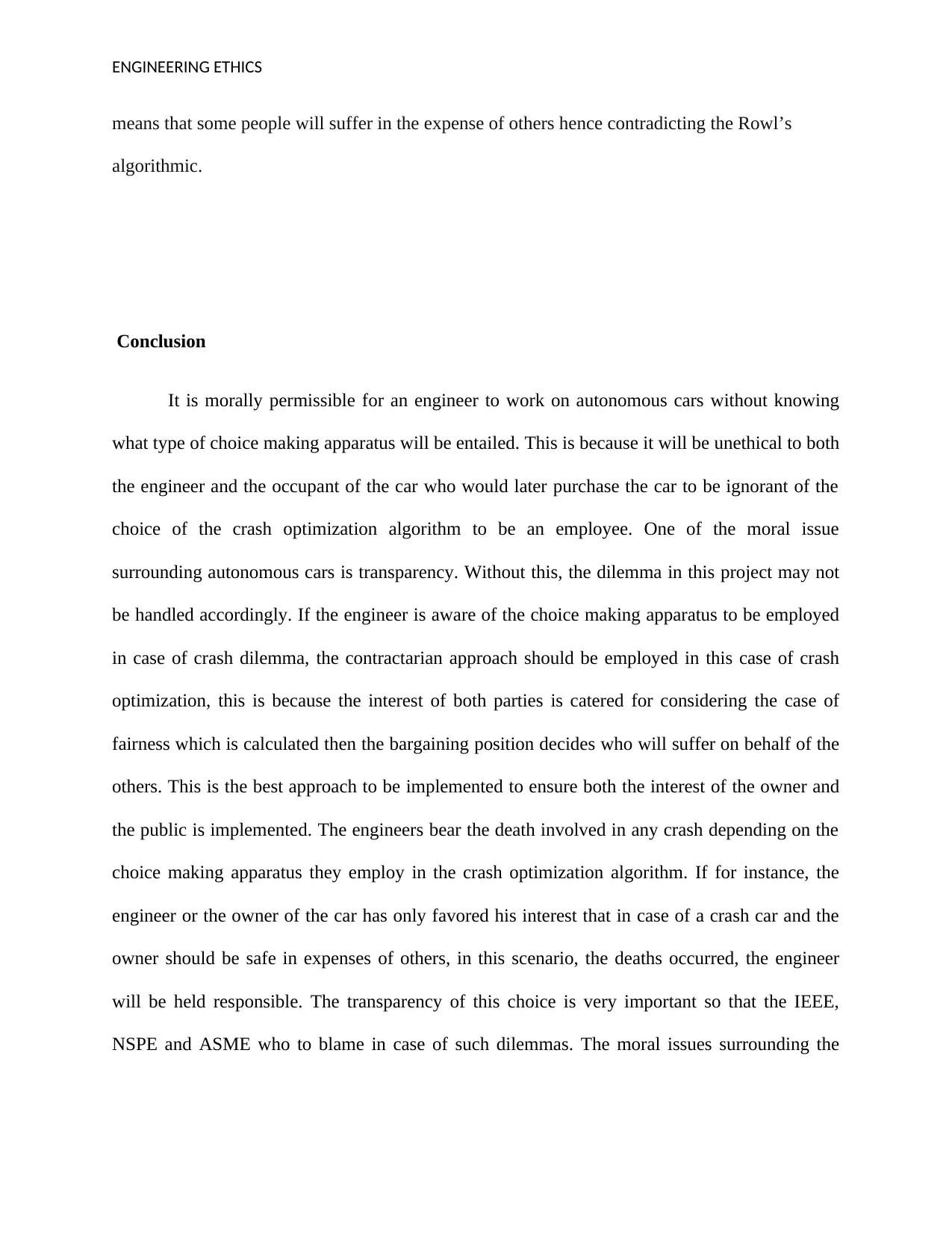
ENGINEERING ETHICS
means that some people will suffer in the expense of others hence contradicting the Rowl’s
algorithmic.
Conclusion
It is morally permissible for an engineer to work on autonomous cars without knowing
what type of choice making apparatus will be entailed. This is because it will be unethical to both
the engineer and the occupant of the car who would later purchase the car to be ignorant of the
choice of the crash optimization algorithm to be an employee. One of the moral issue
surrounding autonomous cars is transparency. Without this, the dilemma in this project may not
be handled accordingly. If the engineer is aware of the choice making apparatus to be employed
in case of crash dilemma, the contractarian approach should be employed in this case of crash
optimization, this is because the interest of both parties is catered for considering the case of
fairness which is calculated then the bargaining position decides who will suffer on behalf of the
others. This is the best approach to be implemented to ensure both the interest of the owner and
the public is implemented. The engineers bear the death involved in any crash depending on the
choice making apparatus they employ in the crash optimization algorithm. If for instance, the
engineer or the owner of the car has only favored his interest that in case of a crash car and the
owner should be safe in expenses of others, in this scenario, the deaths occurred, the engineer
will be held responsible. The transparency of this choice is very important so that the IEEE,
NSPE and ASME who to blame in case of such dilemmas. The moral issues surrounding the
means that some people will suffer in the expense of others hence contradicting the Rowl’s
algorithmic.
Conclusion
It is morally permissible for an engineer to work on autonomous cars without knowing
what type of choice making apparatus will be entailed. This is because it will be unethical to both
the engineer and the occupant of the car who would later purchase the car to be ignorant of the
choice of the crash optimization algorithm to be an employee. One of the moral issue
surrounding autonomous cars is transparency. Without this, the dilemma in this project may not
be handled accordingly. If the engineer is aware of the choice making apparatus to be employed
in case of crash dilemma, the contractarian approach should be employed in this case of crash
optimization, this is because the interest of both parties is catered for considering the case of
fairness which is calculated then the bargaining position decides who will suffer on behalf of the
others. This is the best approach to be implemented to ensure both the interest of the owner and
the public is implemented. The engineers bear the death involved in any crash depending on the
choice making apparatus they employ in the crash optimization algorithm. If for instance, the
engineer or the owner of the car has only favored his interest that in case of a crash car and the
owner should be safe in expenses of others, in this scenario, the deaths occurred, the engineer
will be held responsible. The transparency of this choice is very important so that the IEEE,
NSPE and ASME who to blame in case of such dilemmas. The moral issues surrounding the
Paraphrase This Document
Need a fresh take? Get an instant paraphrase of this document with our AI Paraphraser

ENGINEERING ETHICS
autonomous vehicles played a major role in these dilemmas and determine whether the engineers
are to be blamed in several deaths caused by the autonomous cars.
Bibliography
autonomous vehicles played a major role in these dilemmas and determine whether the engineers
are to be blamed in several deaths caused by the autonomous cars.
Bibliography
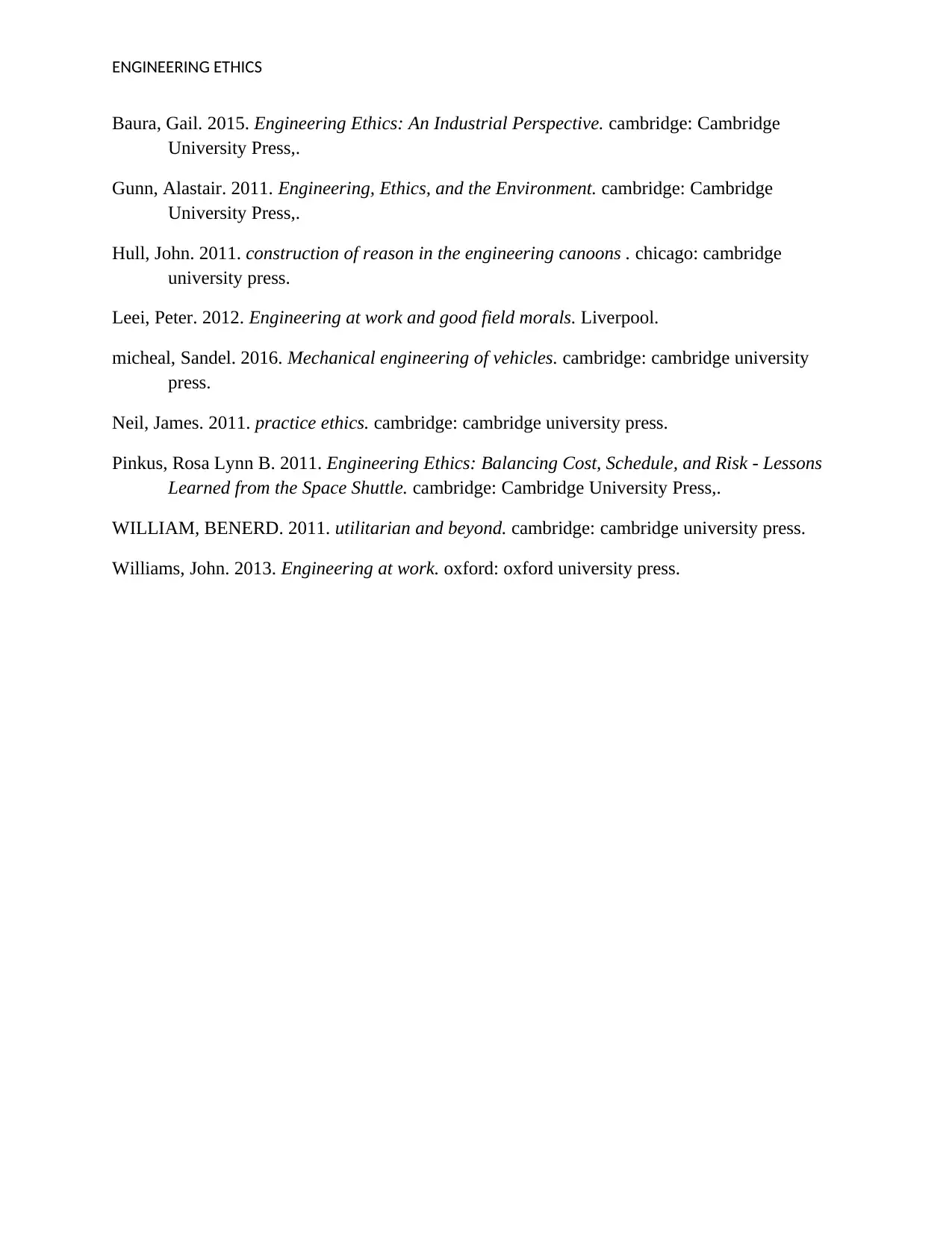
ENGINEERING ETHICS
Baura, Gail. 2015. Engineering Ethics: An Industrial Perspective. cambridge: Cambridge
University Press,.
Gunn, Alastair. 2011. Engineering, Ethics, and the Environment. cambridge: Cambridge
University Press,.
Hull, John. 2011. construction of reason in the engineering canoons . chicago: cambridge
university press.
Leei, Peter. 2012. Engineering at work and good field morals. Liverpool.
micheal, Sandel. 2016. Mechanical engineering of vehicles. cambridge: cambridge university
press.
Neil, James. 2011. practice ethics. cambridge: cambridge university press.
Pinkus, Rosa Lynn B. 2011. Engineering Ethics: Balancing Cost, Schedule, and Risk - Lessons
Learned from the Space Shuttle. cambridge: Cambridge University Press,.
WILLIAM, BENERD. 2011. utilitarian and beyond. cambridge: cambridge university press.
Williams, John. 2013. Engineering at work. oxford: oxford university press.
Baura, Gail. 2015. Engineering Ethics: An Industrial Perspective. cambridge: Cambridge
University Press,.
Gunn, Alastair. 2011. Engineering, Ethics, and the Environment. cambridge: Cambridge
University Press,.
Hull, John. 2011. construction of reason in the engineering canoons . chicago: cambridge
university press.
Leei, Peter. 2012. Engineering at work and good field morals. Liverpool.
micheal, Sandel. 2016. Mechanical engineering of vehicles. cambridge: cambridge university
press.
Neil, James. 2011. practice ethics. cambridge: cambridge university press.
Pinkus, Rosa Lynn B. 2011. Engineering Ethics: Balancing Cost, Schedule, and Risk - Lessons
Learned from the Space Shuttle. cambridge: Cambridge University Press,.
WILLIAM, BENERD. 2011. utilitarian and beyond. cambridge: cambridge university press.
Williams, John. 2013. Engineering at work. oxford: oxford university press.

ENGINEERING ETHICS
1 out of 10
Your All-in-One AI-Powered Toolkit for Academic Success.
+13062052269
info@desklib.com
Available 24*7 on WhatsApp / Email
![[object Object]](/_next/static/media/star-bottom.7253800d.svg)
Unlock your academic potential
© 2024 | Zucol Services PVT LTD | All rights reserved.